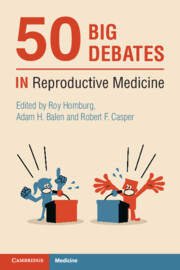Book contents
- 50 Big Debates in Reproductive Medicine
- Series page
- 50 Big Debates in Reproductive Medicine
- Copyright page
- Contents
- Contributors
- Foreword
- Introduction
- Section I Limits for IVF
- Section II IVF Add-ons
- Section III The Best Policy
- Section IV Embryology
- Section V Ethics and Statistics
- Section VI Male-factor Infertility
- 35A Sperm Counts Are Falling Worldwide
- 35B Sperm Counts Are Falling Worldwide
- 36A There Is Value in Examining Sperm DNA Fragmentation
- 36B There Is Value in Examining Sperm DNA Fragmentation
- 37A Testicular Sperm Should Be Considered for Repeated ICSI Failed Implantation Cases in Men with High Sperm DNA Damage
- 37B Testicular Sperm Should Be Considered for Repeated ICSI Failed Implantation Cases in Men with High DNA Damage
- Section VII Genetics
- Section VIII Ovarian Stimulation
- Section IX Hormones and the Environment
- Index
- References
36B - There Is Value in Examining Sperm DNA Fragmentation
Against
from Section VI - Male-factor Infertility
Published online by Cambridge University Press: 25 November 2021
- 50 Big Debates in Reproductive Medicine
- Series page
- 50 Big Debates in Reproductive Medicine
- Copyright page
- Contents
- Contributors
- Foreword
- Introduction
- Section I Limits for IVF
- Section II IVF Add-ons
- Section III The Best Policy
- Section IV Embryology
- Section V Ethics and Statistics
- Section VI Male-factor Infertility
- 35A Sperm Counts Are Falling Worldwide
- 35B Sperm Counts Are Falling Worldwide
- 36A There Is Value in Examining Sperm DNA Fragmentation
- 36B There Is Value in Examining Sperm DNA Fragmentation
- 37A Testicular Sperm Should Be Considered for Repeated ICSI Failed Implantation Cases in Men with High Sperm DNA Damage
- 37B Testicular Sperm Should Be Considered for Repeated ICSI Failed Implantation Cases in Men with High DNA Damage
- Section VII Genetics
- Section VIII Ovarian Stimulation
- Section IX Hormones and the Environment
- Index
- References
Summary
One of the contemporary challenges in treating infertility is to identify those couples that will likely fail to conceive naturally or after assisted reproduction and will require more extensive interventions to achieve conception. The conventional sperm parameters (sperm concentration, motility, and morphology) provide us with information on the functionality of the seminiferous tubules and the reproductive tract. However, a major drawback of the semen analysis is that conventional sperm parameters are crude indicators of male fertility potential and the reference ranges for these parameters were set based on a population of fertile couples who succeeded in achieving a natural conception [1]. Moreover, these same parameters are not useful in predicting reproductive outcomes with assisted reproductive technologies. As such, there is a real need to identify markers that can accurately assess male fertility potential and help predict reproductive outcomes with assisted reproductive technologies
- Type
- Chapter
- Information
- 50 Big Debates in Reproductive Medicine , pp. 186 - 188Publisher: Cambridge University PressPrint publication year: 2021

